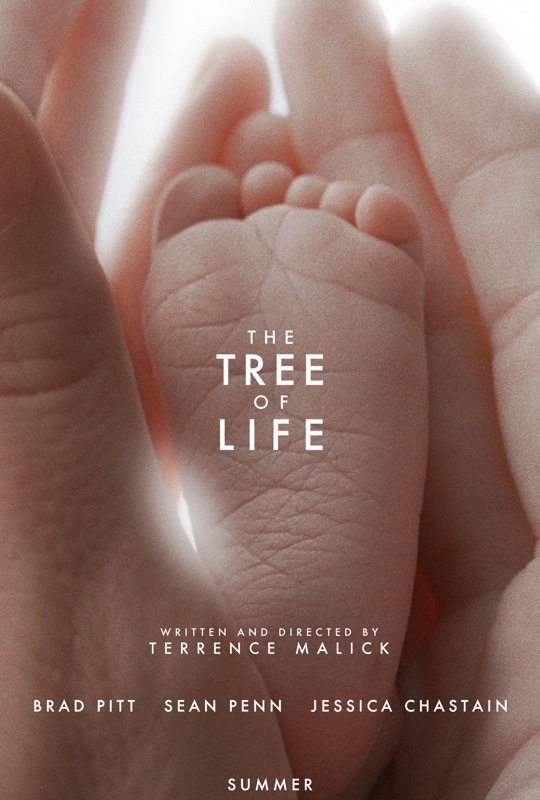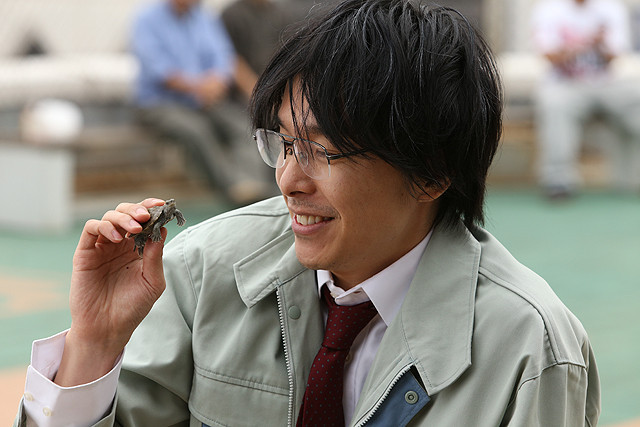When we asked our staff to vote on the best comic book movie adaptations, we were afraid the results would consist only of superhero films. While there are many superhero movies listed below, it is great to see a bulk of non-Hollywood films appearing on the list as well. We set out to compile a list of 50 movies but as it were, we ended up with 5 ties, and so the list consists 55 films instead. Let us know if you think we missed something. Enjoy!
****

55. The Adventures of Tintin
Spielberg’s first venture into animation is one of his best. Taking notes from the classic Raiders of the Lost Ark playbook, Spielberg crafted another spirited, thrilling, and always entertaining adventure. The Adventures of Tintin is one of the most pleasurable, family-friendly experiences, that boils down to one grand treasure hunt. There’s much to admire on-screen, but it is the spectacular action scenes that stand out most. Take for instance the flashback involving the 17th century Haddock battling with the villainous Red Rackham. The sequence narrated by Haddock is brilliantly choreographed as the camera continuously spins around the action while it jumps from past to present. Meanwhile, the big chase scene through a terraced Middle Eastern city also deserves praise: Sakharine pursues Tintin who flees with Haddock on motorbike, while Snowy bolts after Sakharine’s falcon, all in hopes of retrieving three pieces of paper blowing in the wind. This tour-de-force action sequence alone lasts 2 minutes and 38 seconds and was conceived and executed in one single shot. The Adventures of Tintin is another fine entry in Spielberg’s canon and proves once again why he is the master of cinematic escapism suitable for the entire family. (Ricky D)

54. Gainsbourg: A Heroic Life
Comic book artist Joann Sfar interprets the life of ’60s pop star Serge Gainsbourg (played here by Eric Elmosnino), beginning with his childhood years in Nazi-occupied Paris, through his early years as a painter and jazz musician, to his life as a wildly popular singer-songwriter. Sfar won the Cesar for Best First Film for this directorial debut and it is easy to see why. Both evocative and faithful in its depiction of the famed French singer’s lascivious life, Gainsbourg finds a unique artistic way to tell the story of one man’s life. Sfar’s most audacious move is to give his hero an alter ego in the form of a giant, cartoon-looking bad-boy with an outsize head who haunts Gainbourg’s thoughts throughout his entire adult life. Gainsbourg’s two-sided personality and his over-the-top antics with Brigitte Bardot (Laetitia Casta), Jane Birkin (Lucy Gordon), and beatnik icon Juliette Gréco (Anna Mouglalis) share the movie’s best moments, and Sfar packs the soundtrack with one classic tune after another, which help keep the film flowing even as the story begins to run out of steam. The animation if superb and the cinematography is gorgeous, but the reason to see this biopic, is for the powerful, gripping performance from actor Erik Elmosnino. (Ricky D)

53. Fritz the Cat
There was a time when Fritz the Cat was the most familiar character of the Underground Comix scene – so popular that Robert Crumb’s most famous creation served as the basis for a pair of film adaptations produced by Steve Krantz: Fritz the Cat 1972, directed by Ralph Bakshi, and The Nine Lives of Fritz the Cat 1974, directed by Robert Taylor. The first film went on to become a worldwide hit, grossing over $100 million and at the time, was the most successful independent animated feature ever. Despite it’s shortcomings, Bakshi delivered one of the more creative and daring forays in feature-length animation – even if the unsatisfied Crumb, disowned the project. Fritz the Cat, like the comic, is often amusing and always provocative and will forever bear the distinction of being the first “X-rated animated movie.” (Ricky D)

52. A Boy and His Samurai
A Boy and His Samurai (Chonmage Purin) is an enjoyable entry from Fish Story director Yoshihiro Nakamura. Single mother Hiroko (Rie Tomosaka) and her son Tomoya (Fuku Suzuki) encounter a samurai that has time-travelled from the Edo period to the present in Japan. With the combination of Hiroko’s hectic work schedule and Tomoya’s fascination with this figure from the past, it is agreed upon that the samurai, Yasube (Ryo Nishikido), will stay with the young family. What begins as a fascination and bewildered examination of the present time from Yasube’s perspective, turns into a deep appreciation and heavy involvement in a very important housemaid task: cooking.
Based on the manga by Gen Araki called Fushigi no Kuni no Yasubei, Nakamura presents a story that is light and fun in tone but is layered with a concern for the contemporary Japanese society. The further Japan distances themselves from their past as time moves forward, there is a hope that there will remain an understanding and respect for the past.
Ryo Nishikido captures the strict manners of a Samurai naturally while acting hilariously shortly after in reaction to modern household appliances like the microwave. His nuanced performance captures most of the film’s great moments alongside the charming, curious energy of Fuku Suzuki’s Tomoya. Rie Tomosaka does a good job capturing the conflicting emotions of balancing the roles of mother and sole provider before welcoming Yasube less so as a partner, and more so the samurai as a friend and companion for Tomoya.
Heed one single warning: do not view A Boy and His Samurai on an empty stomach. (Anthony Spataro)

51. Teenage Mutant Ninja Turtles
Arriving at the peak saturation of a multimedia fad, Teenage Mutant Ninja Turtles appeared absurd to critics and baffling to the many parents forced into theaters. But since then, the acceleration of superhero action movies into the bread and circuses of digital spectacle, as well as a string of increasingly brain-dead live action installments, have recast the film as almost a bravura miracle. Financed by legendary Hong Kong production house Golden Harvest (previously responsible for popularizing Kung Fu cinema via export to the West), the film dodged the tone of the then ubiquitous cartoon series for an almost straight adaptation of the much darker source material. With then-cutting-edge puppetry provided by the Jim Henson Creature Workshop (made almost more charming by the intermittent visibility of performers’ faces through the turtle’s open mouths) the film fits in more with the oeuvre of late period Henson fantasies like Labyrinth and The Dark Crystal then even its own sequels. Though successful enough to warrant a rushed follow-up, the film’s own controversial levels of violence and cursing led to a sanitation of tone and content that would sink the series within a just a few years. But just as its 2014 reboot gave us New York City in the post-Giuliani era of Times Square decadence and terrorism paranoia, Teenage Mutant Ninja Turtles is arguably most notable for distilling the essence of New York City in the final days of its postindustrial grime. (Adam Hofbauer)
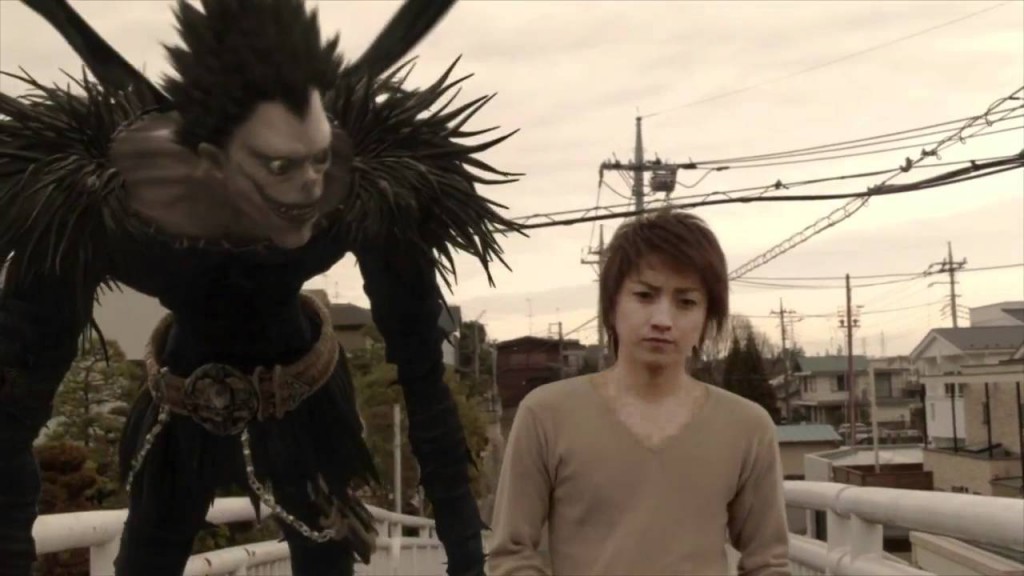
50. Death Note
Having previously seen cinematic life as an animated series, this is the first of three live-action films based on the graphic novel series by writer Tsugumi Ohba and artist Takeshi Obata. The film stars Tatsuya Fujiwara as a student named Light who uses a supernatural book to rid the world of people he considers either evil or a threat to his goals. The wave of death he causes is attributed to someone named “Kira” and law enforcement agencies scramble to identify and capture the mass murderer. Joining the investigation is a famous but mysterious detective known as L.
Death Note is a unique high-stakes chess match between two brilliant characters that manages to stay on course in spite of the occasional cartoonish presence of demonic CGI beings that, while very faithful to the film’s source material and animated incarnation, become distractions from the narrative. The real star of the show here is Kenichi Matsuyama as the sweets-obsessed detective L. Matsuyama, charismatic and very quiet in the role, delivers an outstanding performance that is so subdued it makes Ryan Gosling in Drive look like Jim Carrey.
Matsuyama also starred in Shinsuke Sato’s great alien invasion graphic novel adaptation Gantz (2010) and its lesser 2011 sequel and delivers an impressive physical performance as the lead in Yoichi Sai’s chambara film Kamui (2009).
Death Note’s story is concluded in Gamera trilogy director Kaneko’s Death Note: The Last Name, also released in 2006, and Kenichi Matsuyama returned to the L role in Ringu director Hideo Nakata’s L: Change the World (2008)-an only fitfully successful non-supernatural suspense thriller pitting L against a bio-terrorism plot. (Terek Puckett)

49. Fudoh The New Generation
Fudoh: The New Generation helped bring Takashi Miike out of direct-to-video obscurity and into the international film scene. Like all of his previous movies it was intended for video release, but his employers were so impressed by this subversively darkly comic tale of generational redemption they bumped it to a Japanese theatrical screening, which even got it play in several festivals outside of Japan, most notably the Toronto International Film Festival. In Miike’s video-cinema years, he almost exclusively made gangster/Yakuza films, Fudoh being no exception. But what set it apart was Miike’s growth as a visual artist, and willingness to push the content beyond what was expected of traditional gangster movies. His previous movies were mostly played-for-straight actions and crime sagas, whereas Fudoh is the first of his films to embrace surrealism and comedy to a large extent, and its willingness to turn things loose and become extravagant would become a staple of Miike’s style. Fudoh: The New Generation is just as dramatic as it is comical, however, refusing to soften the blows attached to its core narrative, the son of a Yakuza boss swearing revenge on his father after murdering his brother to appease his superiors. It’s a movie that depicts violence in two modes; as a toxic force of human nature that breeds further violence, and as an absurd thing that humans do that defies all logic. These two modes describe not just Fudoh, of course, but literally dozens of the movies that Miike would make after. Takashi Miike is a pacifist filmmaker, and his filmography is so equally fascinated, disgusted and befuddled by human violence that sometimes the only way to depict it is through an outlandish, blood-splattering-across-the-
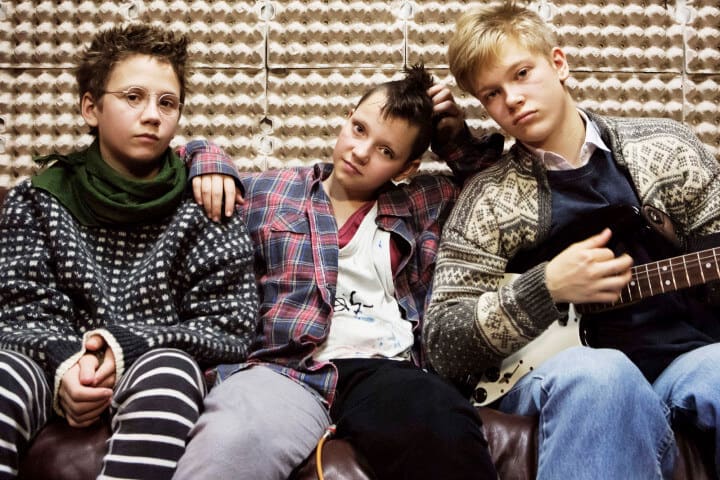
48. We Are the Best! (Vi är bäst!)
Seven features into his career, Lucas Moodysson surprised us all with We Are The Best, a wonderful Swedish comedy adapted from a semi-autobiographical graphic novel by Moodysson’s wife, Coco. We Are The Best is the rare coming of age film that doesn’t seem exclusively targeted either to teens or to adults. The movie follows three young misfits growing up in early ’80s Stockholm. Klara (Mira Grosin) and her best friend Bobo (Mira Barkhammar) are 13-year-old rebels looking for a cause, and look to music to express their anxiety. Despite having no instruments or discernible musical talent, the two put all their energy into forming an all-girl punk band, recruiting their shy, classical guitar-playing schoolmate Hedvig (Liv LeMoyne) as the third wheel. We Are The Best is smart, funny, heartwarming and features three remarkable performances from the trio of young actresses. Along with the early-1980s setting, the fist-pumping soundtrack and one of the finest end-credits gags in recent memory, We Are The Best makes for an exhilarating watch all the way through – (Ricky D)
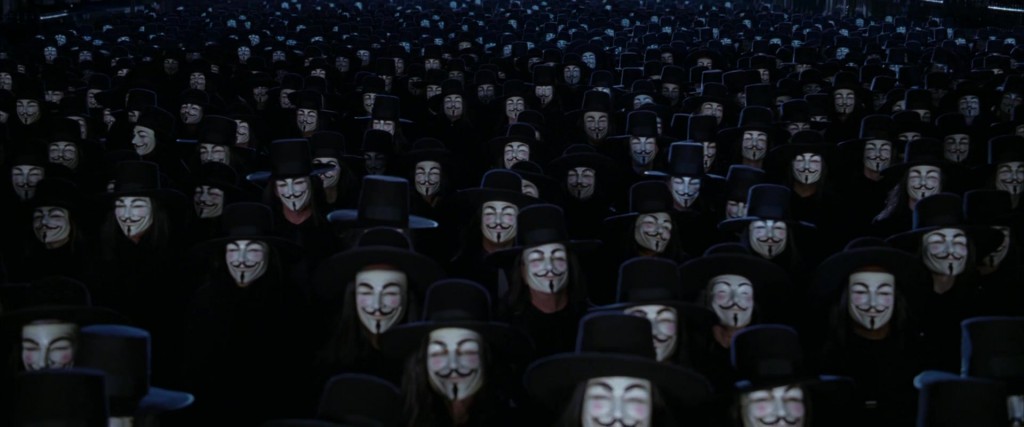
47. V for Vendetta
V for Vendetta, in the original Alan Moore comic form, had a massive cultural impact. Set in the mid 1990’s after a nuclear war, the Norsefire Party has taken control of London. The party rules with an Orwellian level of fear and surveillance. A lone terrorist/vigilante named simply “V” stalks the elite party members and has enlisted the help of a young media intern named Evey Hammond. The comic was built around author Alan Moore’s fears of totalitarianism and oligarchy, themes that have resonated heavily with generations of readers.
In 2006, the comic finally received a film adaptation scripted by the Wachowski siblings. Hugo Weaving starred as the iconic character, maintaining the iconic symbolism of the comic by never once removing his mask on camera. The film is riddled with nods and references to the letter V, some are subtle and some are extremely overt. Moore’s characters came to life on the big screen, and reached an even wider audience than his comic. The titular character’s mask, crafted in the image of revolutionary Guy Fawkes, has become a symbol for anti-government and anti-Wall Street protest movements including the multinational Occupy movement. It has been stated that the title character V was even influential at the start of the recent Egyptian revolution. The mask is also the face of the international organization known as “Anonymous”. It’s easy to see that V for Vendetta’s themes are both incredibly far-reaching and resonant with so many of it’s viewers. (Cory Weddell)
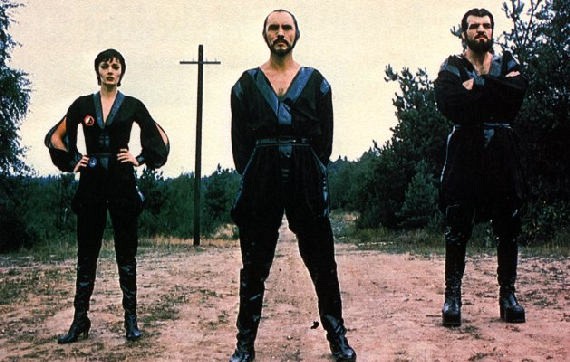
46. Superman II Director’s Cut
Comic book movies simply don’t get much better than Richard Donner’s cut of Superman II. Having directed the first film and having completed a good chunk of filming on the second, Donner found himself replaced by the producers over creative control. It’s a shame, because as you can see now, Donner’s cut is clearly the superior film. There is less of a tonal clash as replacement director Richard Lester leaned more towards comedy than drama, and Donner’s footage helps create a streamlining narrative between the first film and this one, as both were conceived as one long story. Still though, one of the most heroic cinematic moments comes in the climax when Superman regains his powers and returns to save Metropolis. The film has spent a significant amount of time amping up the suspense for Superman’s return, and they deliver on it. John William’s score starts to play as a wind blows over some newspapers. Superman, who appears in front of the Daily Planet and General Zod, delivers a snappy one-liner: “General….would you care to step outside?” That sort of heroic storytelling in cinema has become influential and iconic. Comic book movies don’t have moments quite as cinematically thrilling and heroic as that. (Dylan Griffin)

45. The Rocketeer
Plenty of films that appear on this list star comic book characters who are more well-known to both movie-goers and comic book readers alike than Dave Stevens’ Rocketeer, but arguably no film better captures the swashbuckling charm of classic comic books like The Rocketeer. Director Joe Johnston (who would go on to cover similarly retro ground in the first Captain America film) creates a pre-war world of square-jawed heroes, attractive-but-tough women and sinister villains. Billy Campbell brings an aw-shucks charm to the title role as stunt pilot Cliff Secord, who gets drawn into a dangerous battle between the FBI, the mob and Nazi insurgents when he finds a high-tech jetpack that allows him to fly. Jennifer Connelly, in an early role, is perfectly cast as Cliff’s girlfriend Jenny, and makes the most of a script which smartly allows her to do more than just the usual damsel in distress routine. Timothy Dalton (during his stint as James Bond), playing the Errol Flynn-esque actor Neville Sinclair, strikes just the right balance between suave charm and villainous scenery-chewing. The cast is rounded out by Alan Arkin, as the warm and funny Peevy, Cliff’s mechanic friend, and Paul Sorvino as an archetypal 30s era mob boss. Elevated by a soaring, bombastic score from James Horner (one of the composer’s best), The Rocketeer is both retro and timeless, sincere but not hokey, and most of all, grinning-from-ear-to-ear fun. (Austin Gorton)
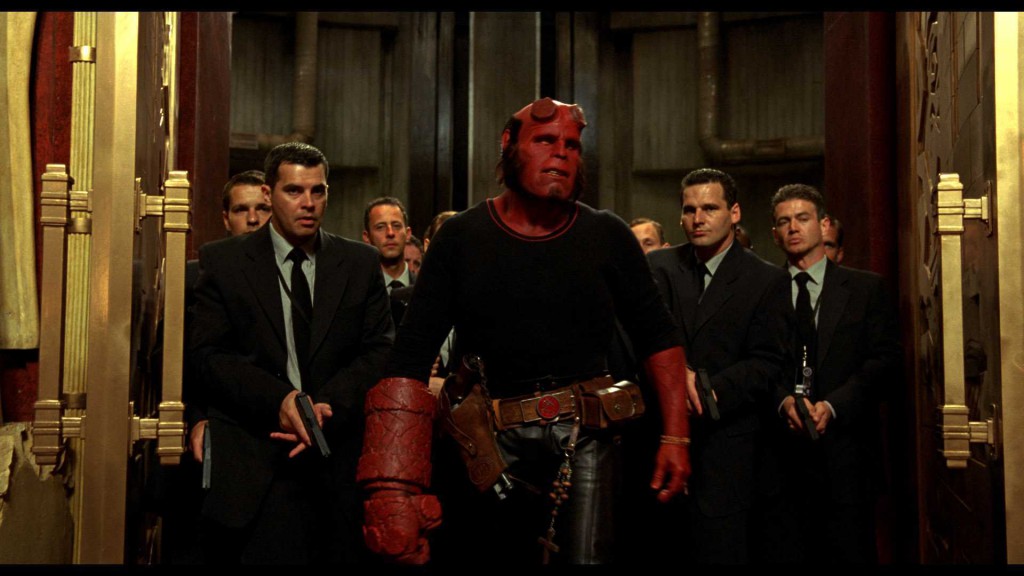
44. Hellboy 2
Hellboy 2: The Golden Army is almost a textbook example of how to do an effective sequel. First, cut away the fat. In this case, “the fat” is the bland-as-an-unadorned-saltine Agent Myers, who gets axed now that his job of serving as an exposition facilitator/audience surrogate is fulfilled.
Second, ramp things up in just the right ways while not going too big. The clockwork Nazi assassins and Lovecraftian horrors of the first film are replaced with dark elves and an army of magical robots, which takes the visuals in a new direction, keeping things fresh. The fantastic practical effects and sets from the first film are appropriately stepped up, the absolute highlight being the Troll Market scene, which stands up with the Cantina sequence from Star Wars for the sheer number of creatively designed and incredibly executed practical effects creatures on screen at any given second. Finally, newcomer Seth McFarlane joins the cast as the fun and interesting ectoplasmic German psychic Johann Krauss
All in all, Hellboy 2 presents just as much, if not more, of what made the first film memorable, fun and visually astounding — and the one-two punch of the two films have ensured that even years later, the fans (and Hellboy himself, Ron Perlman!) are still clamoring for more. (Thomas O’Connor)

43. Iron Man 3
Iron Man 3 is one of the few Marvel Cinematic Universe films that had a distinct directorial style while also continuing the story of the hero that kicked off this blockbuster starting juggernaut. Writer/director Shane Black uses all his trademarks in the film from setting it at Christmas to crafting an exciting buddy team-up sequence between Tony Stark (Robert Downey Jr.) and Rhodey (Don Cheadle) sans Iron Man or War Machine suits that evokes the spirit of his work on Lethal Weapon. Composer Brian Tyler also blends orchestral music and the guitars that drove the first two films to create an exciting heroic theme for Iron Man that comes to play during the most dangerous and climactic sequences.
Like its protagonist, Iron Man 3 blends action, comedy, and serious emotional issues well. The funniest part of the film (and the one that made some fanboys groan) is Black’s revisionist take on the classic, yet jingoistic Iron Man villain The Mandarin by making him a paid actor named Trevor and played with gusto by Ben Kingsley. The lack of a big external foe allows Tony Stark to wrestle with his inner demons, including PTSD from almost dying in Avengers, his relationship with Pepper Potts, and his legacy. However, Black tempers this darkness with oodles of snarky one-liners, some unlikely team-ups, and a fireworks worthy, final setpiece involving virtually every Iron Man suit from the comics to make Iron Man 3 simultaneously personal and explosive. (Logan Dalton)

42. Sin City
Although Sin City hangs its hat on stylization more than substance, it does a great job of replicating the comic book experience. There’s something to be said for re-creating the noir and hardboiled detective stories for a modern audience that doesn’t necessarily have the familiarity of Raymond Chandler and exaggerating it so far that it becomes totally engrossing. Added to those aims are Sin City’s split narratives, which eschew linearity and cohesiveness in favor of bringing its central characters to life in tight vignettes.
There’s such an eclectic cast of characters in Sin City that there’s bound to be someone or something for any viewer to latch onto. Whether that’s Mickey Rourke’s legitimately impressive turn as Marv or the villains of varying horror (Elijah Wood’s Kevin and the grotesque and disturbing yellow man played by Nick Stahl stand out), Sin City embraces the ideas of good and evil and finds people to fit on nearly every point of that spectrum.
In that sense, the film does a better job of being a comic book movie than a lot of entries on this list even if it does a worse job being a film on its own. But when so many recent adaptations have either been aimed at a wider audience via accessibility and easy entertainment or, in the case of Nolan’s Batmans, attempted gritty realism, Sin City stands out for doing its own thing and not worrying about what people think of that aesthetic. As popular film becomes more homogenized, things like Sin City deserve an extra bit of love for taking more risks than concessions. (Sean Colletti)
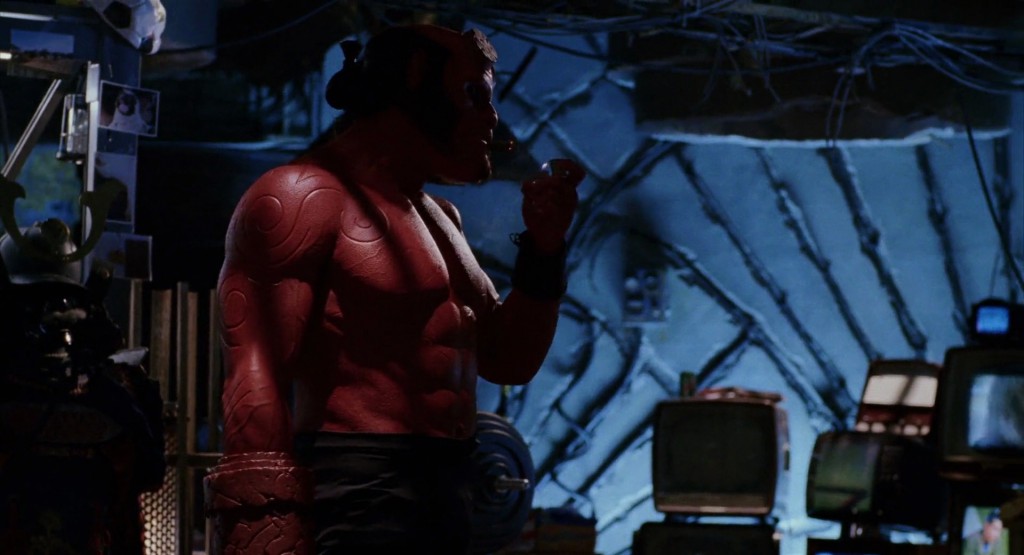
41. Hellboy
It would have been easy for Hellboy to be left out of the “serious and gritty” era of comic-book films in the early aughts. Nazis employing Rasputin to conjure demons to help them win World War II is a little more odd compared to, let’s say, the tamer origins of Spider-man. Fortunately, the fantastical elements inside the mind of Guillermo Del Toro wound up splashed on movie screens nationwide. Such originality in the comic-book genre was refreshing in a crowded landscape full of heroes with little variation or flair to their name. Lovecraftian monsters, gothic backgrounds and vibrant colors were perfectly matched to the talents of Del Toro, but the real highlight here is Ron Perlman, who has an absolute blast as Hellboy. A perfect mix of Humphrey Bogart and the Hulk, Hellboy doesn’t lack confidence and he’s never short of a witty one-liner. Hellboy doesn’t have the mainstream popularity of Batman, Superman or Wonder Woman, yet this is the hero who has fans clamoring for sequels in a time where superhero fatigue is starting to set in. Del Toro avoids such pratfalls by dumping the endless exposition and backstory in favor of blending character interactions and entertaining set-pieces into a wholly entertaining picture. More comic-book films and their directors should take a lesson.
40. Road to Perdition
One of the more surprising and lesser-known facts about Sam Mendes’ second film, Road to Perdition, is that it’s actually adapted from a graphic novel of the same name by Max Allan Collins. The plot follows Michael Sullivan (Tom Hanks), an Irish mob enforcer as he goes on the run with his son Michael Jr. after Jr. witnesses a murder and their family is killed in an effort to cover up any witnesses. There’s many great things in this film that standout, such as Jude Law’s creepy performance as assassin Harlen Maguire, one of Paul Newman’s final and finest performances as mob boss John Rooney, and Hollywood got an early look at the talent of Daniel Craig as the unstable Connor Rooney. However, it’s the climax that remains the most memorable thing in it, featuring some of the most iconic work from its Director of Photography Conrad P. Hall – and also his last work. Sullivan ambushes Rooney and kills all of his men with a machine gun. You don’t see him as he does this, you just see his shots bursting through the darkness as the rain pours down. He approaches Rooney, who just says, “I’m glad it was you.” So much of their dynamic is communicated in just that one line, and the scene is gorgeous to watch. That’s filmmaking right there. (Dylan Griffin)

39. Batman Returns
Almost pathologically dark, brimming with an overt leather fetish and featuring as little Batman as seemingly possible, Batman: Returns, superficially, fails as adaptation. With 1989’s Batman, director Tim Burton had carved out his own territory for the character, but the film hewed close enough to the recognizable (and made an enough money) to grant him total authorial control for the sequel. As Burton’s blockbuster sensibilities have deteriorated, Batman: Returns remains the purest melding of his idiosyncrasies with the excess of large scale production. Relocate the Gotham City of the first film to a Christmas setting that required maintaining multiple sound stages at freezing temperatures? Put Danny Devito in freak makeup and have him drive around a giant mechanical duck? Center a film merchandised in Happy Meal toys around a plot to kidnap children? Make it all obliquely sexual? It all sounds like the result of a mad lib, but whatever Burton wanted he seemed to get, and the result is a superhero film the likes of which we may never see again: violent, weird and ultimately filled with a very adult sadness. In 2015, studio mandate forced Joss Whedon to fill his follow-up to the most successful superhero film of all time with unwanted setups for future ‘in universe’ films. In 1992, Tim Burton concluded his follow-up to the then most successful superhero film of all time with herds of mind controlled penguins with rockets strapped to their backs. Much celebrating has been made of the ascendancy of the comic book film to the top of the box office ladder. Batman: Returns makes it impossible not to wonder what kind of freedoms the genre has lost in the bargain. (Adam Hofbauer )

38. Tales from the Crypt
A precursor to George Romero’s Creepshow: Tale From The Crypt was adapted from a paperback edition of five short stories drawn from William Gaines’s famous comic book about five strangers who while lost on a tour of old English catacombs, wander into a meeting with a strange who proceeds to tell each of them their unpleasant fates. Easily one of the best Amicus films, and also one of the greatest horror-anthology films ever made, Tale From The Crypt is especially memorable for giving each story a lurid, comic book feel without ever feeling completely campy or silly. Like all horror anthologies, not all the stories are great but the first and third segments are first-rate stories, and the ending of the fifth is a classic revenge scenario that has been imitated hundreds of times since. Director Freddie Francis is one of the best horror filmmakers to come out of Britain and whose economy of story-telling is prefect for the anthology film. Lively direction, terrific performances (especially from Peter Cushing) and handful of black humour, makes Tales From The Crypt a must see. (Ricky D)

37. The Crow
In order to successfully adapt James O’Barr’s bleak punk rock revenge tale, New Line elicited the talents of music video director Alex Proyas. He successfully delivers on what is one of the best adaptations of all time. While it’s a loose adaptation, Proyas and co. take what is most crucial from the original source material and inject them into a vicious and haunting tale of revenge from beyond the grave. Brandon Lee is pitch perfect as tortured soul Eric Draven who is gutted by guilt by not being able to stop his wife from being raped and tortured by a local gang. Rising from the grave years later after being murdered by them he enacts a campaign of bloodshed and justice. Lee’s performance is otherworldly, as he injects within Draven shades of madness and torment with every life he takes that helped in inflicting pain on his wife. Though The Crow brings with it a dark legacy with the tragic death of its star Lee during shooting, the final film is a masterstroke of Gothic horror, romance, and vengeance. (Felix Vasquez)

36. Azumi
This adaptation of the popular manga series offers long fluid sequences of hand-to-hand combat and exquisite swordplay; but it also offer little in terms of plot – but that’s ok. As a coming of age drama, it falls short, but as lightweight escapism, it’s pure cinematic delight. If, you’re looking for a great action movie, you can’t go wrong with Azmui. Directed by Ryuhei Kitamura (Versus), the film is populated with the sort of high-flying hysterics found in early Jet Li films, only this time it’s the wildly popular singer and pop icon Aya Ueto who stars as one of the assassins, admirably doing most of the samurai sword stunts herself, while she carves her way through a body count that rivals any three average samurai flicks. Lovers of Asian cinema should love Azumi – a slick, relentless, violent yet beautiful genre piece with breathtaking stunt choreography and impressive wirework by Yuta Morokaji that makes the fight sequences in Kill Bill (released the same year) seem tame. Simply put, Azumi is a jaw-dropping slice of action cinema. (Ricky D)

35. Cemetery Man
Based on the wildly popular Italian comic book Dellamorte, Dellamore from Tiziano Sclavi’s Dylan Dog series, Cemetery Man is compelling, bizarre, and downright entertaining from start to finish. Technically a zombie film, but not really, Soavi’s avant-garde gothic flick weaves in so many unexpected directions, that it is quite unlike any horror film made before or after. This surreal fantasy from the director of Deliria (1987) unfolds like a very weird dream and never stops moving, twisting and turning its way to a beautifully rendered existential climax. You can take it as a horror picture or a black/comedy or a story about friendship, identity and love. Either way it works.
Soavi is a well-known disciple of Italy’s master of horror Dario Argento, and it shows in every frame. The opening scene where Dellamorte disposes off the living dead as he casually chats on the phone is one of the best openings of any horror flick. From the color-drenched scenery and a kiss silhouetted by the full moon, to a camera rotating around a table (Ala Reservoir Dogs), or a steady tracking shot; almost every scene in Cemetery Man is a treat to watch. Even better is the score by Manuel de Sica, a prolific composer who has written over one hundred musical scores for television and film since 1969. His score is a curious blend of synthesizers, and traditional instrumentation accompanied by a catchy theme song that’ll leave you humming long after the credits role. Cemetery Man is the product of an expansive vision, a gorgeously rounded picture that passes through moments of genuine longing and existential crisis – right up to the film’s heart-wrenching mystic finale, in which Francesco will travel to the edge of the world to find some meaning in his cursed existence. Originally titled Dellamorte Dellamore (Of Death and Love), Cemetery Man is one of the most striking Italian genre efforts, and an overlooked, and under-appreciated gem. (Ricky D)

34. X-Men: First Class
First Class gets the characters right. Even though the X-Men films can offer up thrilling actions setpieces like Nightcrawler infiltrating the White House in X2 or the “Time in a Bottle” sequence from Days of Future Past, the reason people keep coming back to these movies is the characters. The big reason Last Stand is (rightly) derided as the worst X-Men movie is because it treats the characters callously, completely botching one of the most tragic character arcs in the history of comics in the Dark Phoenix Saga. Director Matthew Vaughn crafts a story of two extraordinary men in Charles Xavier (James McAvoy) and Erik Lehnsherr (Michael Fassbender) who develop great respect for each other despite their world views at odds with each other. Magneto lifting a submarine out of the ocean with the help of Professor X is a moment of incredible power and catharsis – and one that is cruelly undercut minutes later as Eric holds Charles, now crippled by Erik’s actions, in his arms. It is at this point, the two men realize that their ideas of progress for mutants will forever be a rift between them. Much of First Class is top-notch, tight and efficient superhero blockbuster filmmaking, but there is hardly a more heartbreaking moment in the entire series than when Erik realizes his drive for independence and personhood has led to the handicapping of his closest friend. (Jj Perkins)

33. Flash Gordon
Alex Raymond’s famous comic strip came to life on the big screen in the 1980 Dino De Laurentiis action-packed sci-fi adventure Flash Gordon. The history and making of Flash Gordon is almost as interesting as the film itself. Originally George Lucas wanted to buy the rights to remake the 1930s version, but when he discovered those right had already been purchased by Italian schlockmeister Dino De Laurentiis, he went off to write Star Wars instead. Meanwhile De Laurentiis went through eight different directors, including Frederico Fellini and Nicolas Roeg until finally settling with British director Mike Hodges, who at the time was mostly known for British crime flicks like Get Carter. By the time the film went into production, Star Wars was already a phenomenon and the sequel Empire Strikes Back was set to roll out into cinemas. De Laurentiis had hopes that the success of Star Wars would help Flash Gordon become a box office hit. Unfortunately, things didn’t work out as well as he hoped. Although the film achieved exactly what it set out to do, audiences weren’t prepared for the strange, campy rock opera with its tongue firmly planted in cheek. Due to poor word of mouth and bad reviews, Flash Gordon made only $27 million in domestic gross, and the sequel they promised before the credits role was never made. Simply put, Flash Gordon was terribly misunderstood when it came out, and it’s a shame since the movie is a blast from start to finish. Newcomer Sam J. Jones and screen legend Topol are severely stilted on screen but that only adds to the enjoyment of watching the film. Meanwhile, the more accomplished Oscar winning actor, Max Von Sydow, makes the most of the villain role, Ming the Merciless. Von Sydow is an absolute joy to watch and the colorful playful visuals replicating the panels of the original source material makes this one gorgeous looking film. Standout scenes include the flight of the Hawkmen, the gathering at Ming’s court and the Emperor’s wedding. Oh and did I mention the out-of-this-world special effects and unforgettable music by Queen! Yes folks, Queen does provide the soundtrack for the entire film. Flash Gordon is an exciting live-action adaptation of one of the most popular comic book characters of all time and one of the best science-fiction movies ever made. If you haven’t yet watched the film, do yourself a favor and seek it out. (Ricky D)

32. Blue is the Warmest Color
Never let it be said that a comic book movie hasn’t been a film festival titan or awards season hit. Blue Is the Warmest Colour, based on Julie Maroh’s 2010 graphic novel of the same name, won the Palme D’or at Cannes in 2013, was a breakout success outside of its native France despite an epic runtime and sexually explicit content, and became a controversial talking point for director Abdellatif Kechiche’s apparent tendency towards “moral harassment” during production. Warner Bros. and DC should clearly hire this man to make Blue Beetle Is the Warmest Colour. (I am so, so sorry.)
In being a years-spanning portrait of an (initially) teenage French girl’s life as it relates to one early romance, many have found comparisons between Blue (or La Vie d’Adèle, as it’s known in France) and Mia Hansen-Løve’s 2011 effort Goodbye First Love, with the big differences between the two being length (Blue is two hours, Goodbye under two) and Hansen-Løve’s film’s focus on a more heteronormative relationship. While Goodbye First Love gets across much of the same themes in a more concise manner, Blue Is the Warmest Colour ‘s length does work in its favour for exploring in greater detail the extensive, messy range of emotions and misguided choices that come about when one is in love.
Goodbye First Love may handle things more elegantly, and Kechiche’s film can often feel as afloat as its own heroine, but there s a raw power to both its moments of ecstatic bliss and scenes of devastating disappointment that’s really quite something. And there’s, of course, the fantastic performances from Adèle Exarchopoulos and Léa Seydoux, the former in particular recalling the great Sandrine Bonnaire in the classic À nos amours, another French character study of a young girl navigating her way through love and sex. (Josh Slater-Williams)

31. Lone Wolf & Cub Series
Sword of Vengeance (Kenji Misumi, 1972), Baby Cart at the River Styx (Kenji Misumi, 1972), Baby Cart to Hades (Kenji Misumi, 1972) , Baby Cart in Peril (Takeichi Saito, 1972), Lone Baby Cart in the Land of Demons (Kenji Misumi, 1973), White Heaven in Hell (Yoshiuki Kuroda, 1974)
Based on the Japanese graphic novel series by writer Kazuo Koike and artist Goseki Kojima, this landmark 6 film series starring Tomisaburo Wakayama is the episodic tale of betrayed royal executioner turned assassin-for-hire Itto Ogami and his young son Daigoro.
A unique take on the samurai genre set in Kazuo Koike’s typically strange, occasionally disconcerting but always compelling moral universe, the series is best known for its unforgettable action sequences that usually begin with moments of stillness that explode into deadly conflict punctuated by geysers of arterial spray.
All the films in this series are must-sees but the first three entries directed by Kenji Misumi are the strongest and should ideally be watched consecutively in one sitting.
Action highlights of the series include Ogami’s battle with a cadre of female assassins, his desert showdown with the deadly Hidari brothers and his astonishing one man stands against small armies of enemy warriors.
The series also contains some wonderful lyrical moments such as Daigoro’s life or death choice between a ball and a sword, Daigoro administering water mouth-to-mouth to his severely wounded father and Ogami’s confrontation with a disenfranchised warrior seeking the true meaning of being a samurai.
Actor Shintaro Katsu of the long-running Zatoichi film series initiated the film series as a producer in an effort to transform his talented brother Wakayama into a box-office star.
Wakayama’s intense performances as the stoic and charismatic Lone Wolf Ogami are remarkable and his incredibly fast and powerful swordplay skills are nothing less than amazing. The actor is easily one of the best swordsmen in the history of the chambara genre and the case could easily be made he is the best in a field of more famous peers like Toshiro Mifune, Tatsuya Nakadai and Shintaro Katsu.
The Lone Wolf & Cub series only lasted six films, denying the audience the grim conclusion of the graphic novel series that was included in the unsatisfying, much more sedate and virtually bloodless Akira Inoue 1993 feature film adaptation.
The influential graphic novels also spawned a television series, provided the narrative model for the Max Allan Collins graphic novel The Road to Perdition and its 2002 screen version and inspired years-long talk of an American-produced film adaptation with directors Darren Aronofsky and Justin Lin attached at various times.
If you’ve only seen the Lone Wolf & Cub films in their dubbed and re-scored Shogun Assassin incarnations-the first combining part of Sword of Vengeance and all of Baby Cart at the River Styx and Shogun Assassin 2 being all of Baby Cart to Hades – I implore you to see the original films as they were meant to be seen. It is an entirely different and far more rewarding viewing experience.
Legendary graphic novelist Kazuo Koike’s work has also been the basis for the animated and live action versions of Crying Freeman as well as the two Lady Snowblood films, the Hanzo the Razor trilogy starring Shintaro Katsu and Shinsuke Sato’s Princess Blade. (Terek Puckett)
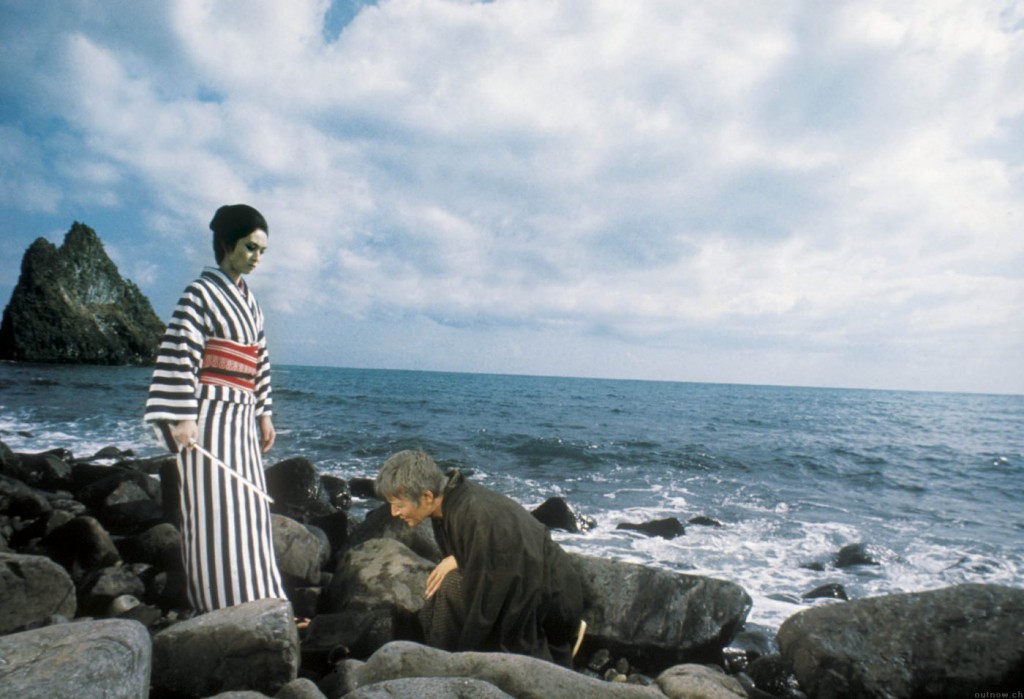
30. Lady Snowblood Part 1 and Part 2
While American comic books have struggled for legitimacy as adult entertainment for decades, their Japanese counterparts have long enjoyed acceptance as legitimate elements of mainstream culture. So while the American comic book movie only properly took off in the last fifteen years, jidaigeki adaptations of popular manga have been a staple of Japanese pulp cinema since the early 1970s. The best of these remains Lady Snowblood, director Toshiya Fujita’s two part revenge opera of a woman checking off a kill list of the gangsters who killed her family and left her for dead. Any familiarity to Kill Bill is entirely intentional, with multiple visuals, soundtrack elements and plot points lifted whole cloth by Tarantino. But even for those only familiar with the update, Fujita’s films remain feats of hard edged efficiency, actress Meiko Kaji a goddess of death in a world of opposing colors and sudden violence. Though Kaji is oddly side lined in the much weaker Lady Snowblood 2 (which, given the fatality that closes the first film, seems hard to believe was anything but a cash grab) both films are bloody reminders that while America may have recently turned to its comic stories for cinematic inspiration, we’ve still got a long way to go before catching up to the legacy of Japan. (Adam Hofbauer)

29. Barbarella
Italian producer Dino de Laurentiis is responsible for three movies appearing on this list: Danger: Diabolik, the remake of Flash Gordon and Barbarella – a kitsch cult classic about a 41st-century astronaut on a mission to find Duran Duran, a scientist who has disappeared along with the galaxy’s deadliest weapon. The plot is blissfully trivial, but Terry Southern’s dialogue livens things up. Meanwhile, the art direction by Claude Renoir is absolutely stunning; the costumes are gorgeous and Jane Fonda gives her most memorable performance.
What many people don’t realize is that Barbarella started as a French science fiction comic book created by Jean-Claude Forest for serialization in the French magazine V in spring 1962. In 1964 Eric Losfeld later published these strips as a stand-alone book which caused quite a scandal and became known as the first “adult” comic-book, despite its eroticism being meager. The original comic book version of Barbarella was modeled on Brigitte Bardot and interesting enough the actress was once married to the director of the 1968 film, Roger Vadim. Barbarella is the best of all Roger Vadim’s films. Besides, what other film features a zero-gravity striptease during the opening credits? (Ricky D)
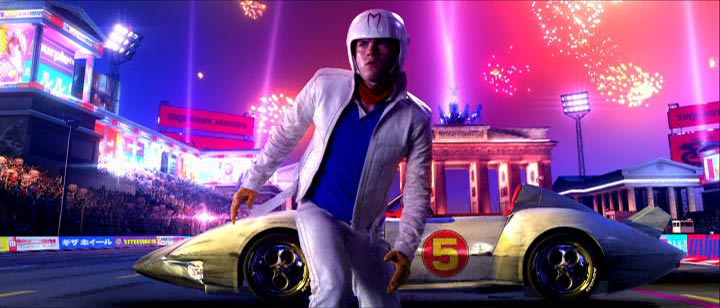
28. Speed Racer
While the Wachowskis’ Speed Racer is primarily based on the Japanese cartoon of the same name (and a series that is revered in some circles as an early pre-cursor to anime), the story also known as Mach GoGoGo was originally serialized in print in Shueisha’s 1966 Shōnen Book. Despite making over 90 million world-wide, the movie was considered a box office bomb due to its high production cost and divided critics. But since the release the film has since gone on to find a dedicated cult following.
Speed Racer is many things: a racing movie, a family film, an action movie, a spy movie, a coming of age film, and a 136-minute cinematic experience like none other. The movie’s unique and sensational visual language (which is heavy influenced by anime), is one of the reasons Speed Racer was rejected by many critics and audiences on its release – And yet, the look of the film is one of Speed Racer’s best attributes. From the first frame, audiences are immersed in a wildly unconventional spectrum of fluorescent colors, gravity-defying car races, swift pans, quick zooms and quirky flashbacks – all of which is served up in a fluid, dreamlike style. Each shot is gorgeously constructed and the Wachowskis expertly use computer digital effects to create a stunning new world. Everything except the actors in this movie were manipulated on a computer – a definitive benchmark for film considering how well put together it is. Not only i Speed Racer a special effects extravaganza but the film was a first in many technical areas, including the first film to employ the Sony F23 digital film camera and the first to employ Codex digital data recorders for on-set uncompressed HD playback. The editing and directing must be praised, even if you’re not a fan of the story. Despite the crazy visual nature of the film, the action is always easy to follow and never once does the narrative lose the explosive momentum it builds the opening minutes. (Ricky D)
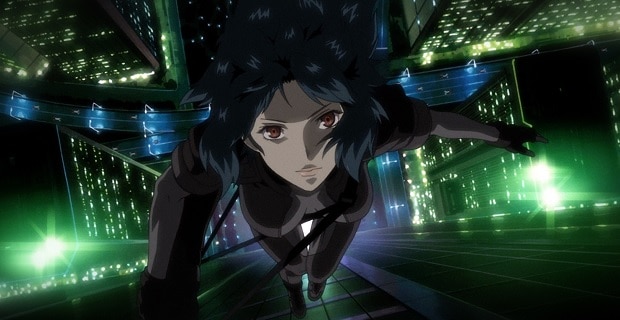
27. Ghost in the Shell
Vastly superior to the manga that preceded it, Mamoru Oshii’s Ghost in the Shell is a visual splendour, thematically dense and with a plot so heavy and layered for its brief 82 minute duration that it almost works best as a minimalist action set piece, with Blade Runneresque world building galore. It’s probably the most influential anime film on Hollywood, having a very direct influence on movies like The Matrix, Dark City, and Lucy, and having an overall influence on the cyberpunk genre. Ghost in the Shell has always been a franchise that walked the line between feminism and objectification and if there’s one major reason for the original manga’s failure, it is the troublesome depiction of Major Motoko Kusanagi, the female-bodied cybernetic-human protagonist of every series iteration. Excessively sexualized and demeaned in the manga, frequently through the lens of the male gaze, the anime takes a step back and re-asserts her presence. She is frequently depicted in little-to-no clothing as in the manga, but in Oshii’s film it is never with sexual or titillating intention. If there is lingering, it is on her body in relationship to the world around her, as subject and not object. Major’s body and identity is a core ingredient in Ghost in the Shell, and the film succeeds in giving her agency. The film shines brightest when Major is on-screen; as vast and complex of a world this is, it almost seems to gravitate around this character. Every other incarnation of the franchise gives Major more personality and human characteristics (Stand Alone Complex does the best job at presenting a more human-like Major), but there’s something so satisfyingly cool about her stoic unfazed demeanour in this film. She’s a rockstar. (Trevor Dobbin)
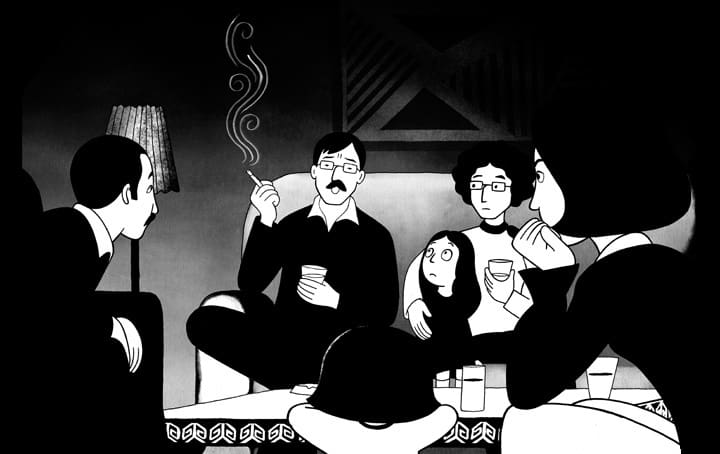
26. Persepolis
Her directorial efforts since might be somewhat questionable (hi, The Voices), but Marjane Satrapi certainly made a crackerjack of a debut with 2007’s Persepolis, a largely black-and-white, animated adaptation of her own autobiographical graphic novel of the same name, which she co-directed with Vincent Paronnaud.
It depicts an adult Marjane (voiced by Chiara Mastroiann) looking back on her childhood in Tehran. Initially rampant with Bruce Lee obsessions and pop music, things take a toll for the worse with the political goings on in Iran. Repression rears its ugly head, and the disillusioned Marji tries to fit in with the realities of an intolerant regime, but as she gets older her outspokenness gets the better of her. Her rebellious ways see her sent abroad by her family so she can be free to express herself, and the directions her life takes offer a potent commentary on both Iran and the concept of staying true to oneself, no matter what the outside pressures. With a deceptively simple two-dimensional animation style and tight 98-minute structure, Persepolis is an enthralling odyssey. (Josh Slater-Williams)
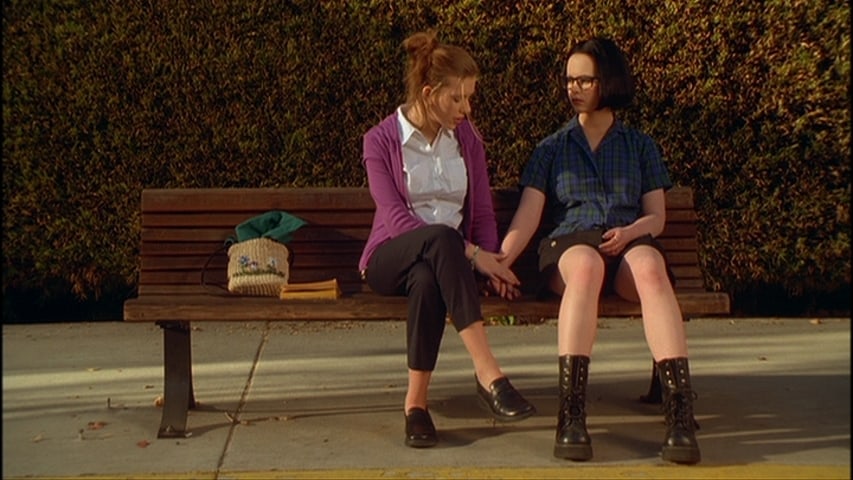
25. Ghost World
It’s slightly miraculous that Ghost World works. That Daniel Clowes’ dry misanthropic wit, counter culture ethics and slacker characters are translatable to film comes as no surprise, these elements have long been incorporated into cinema with success. It’s the Daniel Clowes aesthetic and storytelling structure that do not lend themselves easily to the live-action moving picture medium. Both his Ghost World comic and Terry Zwigoff’s film adaptation capture the mundane through an uninterested lens (as reinforced by the equally unmotivated characters that populate this world); are stripped down, though warped reflections of the world. There is no flashiness or gimmicky in Zwigoff’s Ghost World; even lacking the beautiful ugliness of Clowes’ illustrations that make him so unique. The film lives or dies on the strength of the script and cast, and fortunately, the stars aligned on this one. Clowes had a hand in writing the movie, and his scenarios play out with as much humour and affection the second time around. Rising star Scarlett Johansson gives her first great performance as doe-eyed Rebecca, best friend in the world to Enid, played to perfection by Thora Birch, which tragically did not kick-start a career as long and as satisfying as Johansson’s. If there’s a film role that better illustrates the anguish of adolescence under a cloak of introversion, misanthropy, and disillusionment, I haven’t seen it. Steve Buscemi as Seymour is a character who, to young viewers may seem like the butt of jokes, but who becomes easier to emphasize, with age, and on repeated viewings. He is a middle-aged equivalent to Enid, and their growing camaraderie is as potent a relationship as Enid and Rebecca. Enid sees no problem with her slacker lifestyle and actually looks up to Seymour while Seymour tries to push away because he wants to see Enid do better. Um, did I mention that Ghost World is funny? Underneath all of its morose musings and observations, it maintains a steady dose of laugh-out-loud moments for most of its running time. (Trevor Dobbin)

24. X2: X-Men United
While the first X-Men film proved that modern special effects could be used to create a believable superhero movie, it was a relatively restrained affair, featuring a small number of characters and limited action set pieces. X2: X-Men United is when the series goes nut, as returning director Bryan Singer thrusts breakout star Hugh Jackman’s Wolverine into the center of a story that dives deep into the themes of racism and bigotry for which the comic book is known – meanwhile shifting Ian McKellen’s Magneto into a more nuanced role as a reluctant (though still nefarious) ally, while also setting up the sequel to tackle one of the all-time great X-Men stories (that said sequel utterly squanders this film’s setup is but one of its many problems). X2 also widens the universe of the first film, introducing new characters (like Alan Cumming’s well-crafted turn as the teleporting Nightcrawler) while increasing the length, complexity and intensity of the action sequences. Colonel Stryker’s attack on the X-Mansion, which closes out the film’s first act, still stands as not only one of the franchise’s best action scenes, but one of action cinema’s best, as Wolverine truly cuts loose for the first time to defend the students from Stryker’s nefarious plans. It’s the centerpiece of an exceptional film which not only realizes the promise of the X-Men on screen, but of comic book films as a whole. (Austin Gorton)

23. Kick-Ass
Kick-Ass is a darkly funny, irreverent, and ultraviolent riff on the superhero genre as director Matthew Vaughn begins his tradition of bringing the stylized comic book work of Mark Millar to the silver screen. Vaughn and fellow screenwriter Jane Goldman subvert a lot of stereotypes by making Red Mist (Christopher Mintz-Plasse), the son of a gangster, a likable and nerdy fellow until his fall into supervillainy as well as making a pint-sized, pre-teen girl named Hit Girl (Chloe Moretz’s best performance) the true star of the show. Even though Kick-Ass (Aaron Taylor-Johnson) gets the big emotional arc, Hit Girl gets to be the star of Vaughn’s action sequences, which are part Tarantino, part chambara film with a touch of Adam West’s Batman, especially in Big Daddy’s (an unbridled Nicolas Cage) line delivery.
Kick-Ass is a look at how superheroes would never work in the real world as Kick-Ass takes some heavy punishment, but ends up embracing the fantasy and escapism of the genre by the time Kick-Ass and Hit Girl are flying away on a jetpack after taking out gangsters with katanas, mini-guns, and a Joan Jett song. (Vaughn is skilled at picking the perfect song for his fight sequences.) But Kick-Ass earns this moment after its hero has been beaten up, humiliated, and duped so his revenge and glimpse of being a superhero is well worth it. Kick-Ass is both a dark comedy and triumphant action film, and it balances these two genres through the style of Hit Girl and substance of Kick-Ass. (Logan Dalton)

22. Danger: Diabolik
This super-stylish live-action adaptation of the popular (and still ongoing) 1960 Italian comic book, created by sisters Angela & Luciana Giussani, is easily the best of the string of ’60s European comic-strip/superhero movies. Originally an established cinematographer before becoming a director, Mario Bava was renowned for making a film look much better than its low budget would anticipate, and invented ways to cheat and manipulate the frame to make a scene look more extravagant than it really was (take, for instance, the film’s tower heist). Bava clearly understood how comic book panels were meant to be laid out and he clearly knew how to best transport them to the big screen, creating dynamic compositions which perfectly mimics the original source material. Using whatever natural lines he could find to split the film frame (bed posts, mirrors, bookshelves), Bava smartly mimics the look of a comic-book. He was a master in the use of colours, drowning his images in garish greens, yellow or reds. as well as creating a detailed, three-dimensional world – enhanced by wide-angle lenses, psychedelic sets, and outrageous costumes. It’s amazing when you consider he only spent $400,000 of his allotted $3 million budget, and yet Diabolik looks ten times as costly. Also, worth noting is Ennio Morricone’s outrageous electric guitar and sitar-laden score. It’s easily one of his finest scores, capturing the devilish tone of both the comic and the film while providing the perfect compliment to Bava’s gorgeous set-pieces.
Danger: Diabolik is an absolute pulp masterpiece, having gone on to inspire filmmakers to come, including Roman Coppola’s CQ and the Beastie Boys music video, Body Movin’. Before the credits role, the main character winks to the audience as if to promise a sequel, only the director declined future offers from its producer, Dino de Laurentiis, deciding to continue working on his usual low-budget horror films instead. Despite being a box office flop, Danger: Diabolik eventually found a cult following, and is considered by many (including this reviewer) to be one of the best live-action comic book movies ever made – a hidden gem of the genre – and one of my all-time favourites (Ricky D)
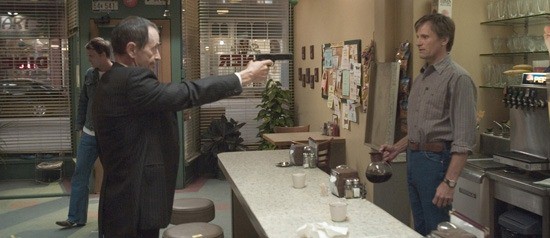
21. History of Violence
There’s a dark side underneath the American Dream, and A History of Violence wants to make sure you see it. As David Cronenberg makes clear from the ominous first scene, something’s rotten in Denmark/small town USA, regardless of the facade carried on by the white picket fences and loving families.
It’s not like the town’s inhabitants don’t do what they can to keep up the illusion. Tom Stall (Viggo Mortnensen, in a shattering performance) runs a humble coffee shop, and he appears to be the perfect husband to his wife, Edie (Maria Bello) and his children (Ashton Holmes and Heidi Hayes). Perfect, that is, until two men attempt to rob Stall’s store, and his heroic defense of his fellow employees leaves the would-be robbers dead. Naturally, his heroism attracts media attention, which in turn attracts the attention of menacing mobster Carl Fogarty (Ed Harris), who claims that Stall is actually the violent gangster Joey Cusack.
Who’s telling the truth? I wouldn’t dare say, but A History of Violence remains a piercing exploration of the implications violence has even if you can figure out early on where the narrative is heading. Cronenberg rubs the viewer’s face in the physical violence, giving it a rough brutality which too many films brush aside while emphasizing the weight of Stall’s actions. But even more penetrating is the emotional violence, as the Stall family struggle not to collapse under the burden of Fogarty’s accusations and their effects. As much as Stall wants to see his dispute with Fogarty as his sole responsibility, he can’t avoid passing it on to his wife and children, regardless of which of them is at fault for the titular history. Violence has a nasty habit of claiming supposed “innocents” as collateral damage, and Cronenberg’s film shows just how tragic its effects can be. (Max Bledstein)

20. Story of Ricky (Lik wong)
–
Starring Siu-Wong Fan as the titular character, Riki Oh, based on a manga series which eventually became an anime, marks the end of an era of Japanese exploitation flicks, before the new generation of filmmakers such as Takashi Miike took over. Unlike Miike’s movies, or other recent entries such as Tokyo Gore Police, Riki Oh’s tone borders on comedy, played up by bad voice dubbing, foolish plot lines, cartoonish gore and eccentric characters (including a one-eyed assistant warden with a hook for a hand). For a prison film, the movie never seems mean-spirited, and if anything it masquerades as a bizarre superhero flick. The effects are the main draw – Riki Oh exists simply to showcase several outlandish set pieces, ramping up the level of violence, gore and action with each new scene. Made before the days of CGI, director Lam relies simply on practical effects, old-school prosthetics, wire work and a ridiculous amount of fake blood. In perhaps the highlight of the film, a man rips out his own intestines to strangle his opponent – meanwhile Riki is capable of punching holes through someone’s abdomen and somehow heals himself with mind puzzling powers. This is one of the true classics of Martial Arts cinema. Outrageous, completely over the top, and a must see. (Ricky D)

19. Snowpiercer
Based off of Jean-Marc Rochette’s French graphic novels Le Transperceneige, the Korean film Snowpiercer (2013) takes place in a post-apocalyptic Ice-Age where the last of humanity lives inside a train traveling annually around the world. The film charts the rebellion of those unfortunate at the back of the train, led by Curtis Everett (Chris Evans), against the few elite who live lavishly within the classist world. Its politically nuanced premise is compelling as the cast of outlandish and original characters break countless taboos. At times the inventive eccentricities of this fantasy/sci-fi behemoth entwine with dystopian tropes to create something that’s rather, well, uncomfortable to watch. Snowpiercer is filthy and gorey in truly satisfying ways and strikes deep into the psyche of humanity and morality. Moreover however, it’s a rollicking gem that entertains in its most resonant moments as well as the more than ample action-packed moments. It’s not so easy to create new dystopian fiction but director Joon-Ho Bong’s innovative and masterpiece certainly feels fresh and relevant amidst the wave of generic films released recently in this genre. Although Snowpiercer was largely overlooked during its limited release, the truly visionary film has already become a cult classic and critical favorite. Also, you must absolutely check out Tilda Swinton’s award-winning transformation into the millionaire conductor’s ridiculous second-in command. (Meg Strickland)
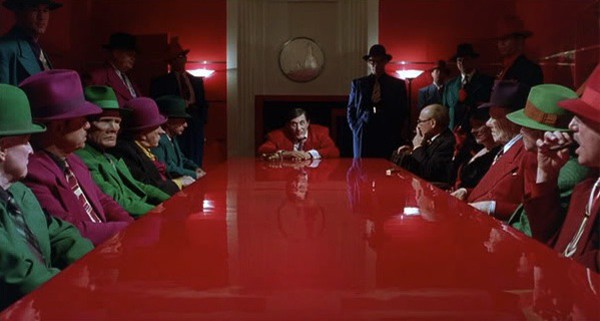
18. Dick Tracy
Dick Tracy, based loosely on the characters created by Chester Gould from his iconic comic strip, is a film that is nowhere near perfect but does a decent enough job at presenting the iconic trench-coat police detective against the criminal underground. Warren Beatty directs and plays the role of Dick Tracy alongside a slew of solid actors from Al Pacino, Seymour Cassel, Dustin Hoffman and many others that find themselves in the role of gangsters throughout their careers. Oh, and Madonna is in it too.
Famed cinematographer Vittorio Storaro captures the heavy shadowed noir style, highlighting the distinct bright colours of the costuming alongside the shady, dimly lit alleys. Danny Elfman creates another memorable bouncy score that really brings out the over-the-top nature of many of the film’s characters and campy nature of the dialogue.
Beatty, alongside a script by Jim Cash and Jack Epps Jr. (screenwriters for Top Gun) embrace the obvious approach that Gould took in the comics of good versus evil. The mob and the various henchmen are physically deformed, for the most part; something that Gould wanted to purposefully capture in the comic to ensure readers knew that a life of crime is an ugly business. Even character names match their grotesque appearances, such as Pruneface, Flattop, and The Brow.
As much as Dick Tracy is campy to the point that lines itself with the similar feel of Batman from the 1960s, it is stylishly shot with some great makeup and costuming, and does feature some memorable performances that evoke a respectable adaptation from comic strip to screen. (Anthony Spataro)

17. Batman (1989)
The Dark Knight is arguably the best the superhero genre has to offer, but I have a fondness for Tim Burton’s Batman. It was the first film I remember watching and it made an impression immediately. (Apologies to my parents who had to watch with me over and over again.) The film was a Jaws-level game-changing blockbuster event in 1989, and is partially responsible for the landscape dominated by franchises today. Batman was a marked difference from the 60s show starring Adam West, but it was both dark and campy in its own right. Burton and Michael Keaton distanced themselves from the television show by delving into the psychology of a man who dresses as a bat to solve crime, but the Clown Prince of Crime (Jack Nicholson) stole the show. Nicholson delivered the definitive Joker on film (at the time anyway), thumbing his nose at authority while having the ability to go full-on menacing simultaneously. Not to be outdone by a villain, Gotham City is more than just a backdrop in the film, it’s a character. Anton Furst won an Oscar for his gothic tribute to Batman’s home and in the 26 years since Batman was released no movie has created such a unique environment as Furst did. Parts of the film are certainly dated, but Batman gave us Michael Keaton, who gave us his infamous line “I’m Batman.” If for no other reason that that, we owe Batman thanks. (Colin Biggs)

16. American Splendor
American Splendor isn’t just a great comic book movie: it’s also one of the great biopics. Too many films in the latter genre leave the viewer wondering why anyone ever cared about their subject in the first place, but the retelling of Harvey Pekar’s life is one of the few which genuinely expresses the spirit of the person it’s depicting. Part of this is due to the unique approach taken by filmmakers Shari Springer Berman and Robert Pulcini: they intersperse the standout performances by Paul Giamatti and Hope Davis with interviews of the real-life Pekar and his wife, Joyce Brabner (played by Davis), as well as one of Pekar’s recurring characters,Toby Radloff. Pekar’s ostensible goal for his work was to use the comic book form to tell stories of real people rather than superheroes or talking animals, and Berman and Pulcini honor his vision by populating their film with, well, real people. As good as Giamatti and Davis are, there’s a certain level of authenticity which only documentary footage can achieve, and American Splendor succeeds by combining the performances and the real-life sequences into a touching hybrid.
Despite the success of these elements of the film, this is a list for comic book movies, and American Splendor is a masterpiece of the genre. Other than Robert Rodriguez’s Sin City, no other film has done an equivalent job of cinematically recreating the feeling of what it’s like to read a comic book. Through having frames which look like comic book panels, introducing places and times in comic book font, and featuring cameos from an animated Pekar, American Splendor functions, in part, as an effective cinematic simulacra of the experience of reading Pekar’s books. Christopher Nolan may have reinvented the comic book movie with his lofty and brooding aims, but I prefer American Splendor’s loving homage to the comic book and the master of the form it depicts. (Max Bledstein)
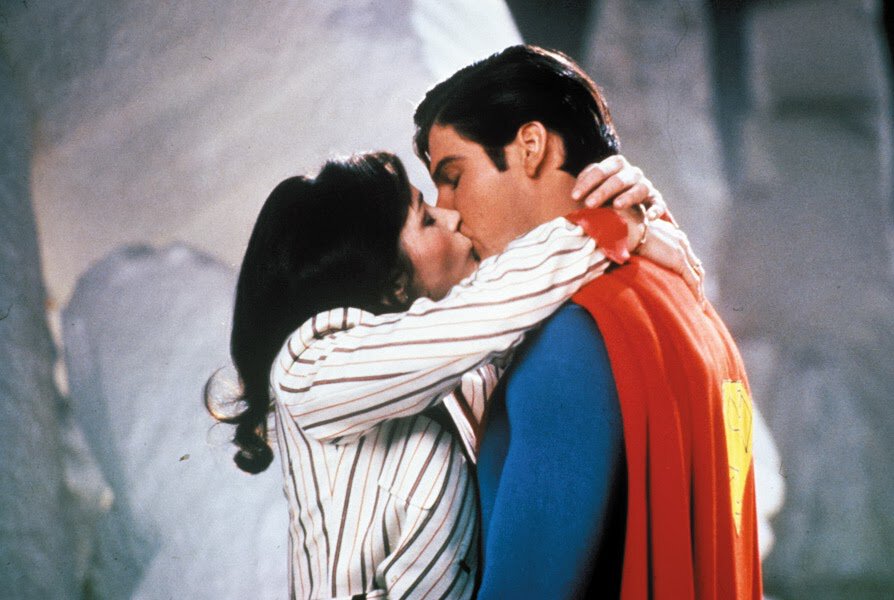
15. Superman: The Movie
For decades, Superman has reigned as America’s foremost folk hero, yet, of all the modifications and adaptations, the one that stands out the most, is Richard Donner’s Superman The Movie. Along with its 1980 sequel, no live-action film has done a better job in capturing the essence of the character (and yes, that includes Bryan Singer’s Superman Returns and Zach Snyder’s Man of Steel). Making good use of the boastful tag line “You’ll Believe a Man Can Fly”, Richard Donner’s big-budget blockbuster Superman: The Movie, is an immensely entertaining rendering of the origin of the famous comic book character. Superman is the first great superhero movie, skillfully blending humour and gravitas, while balancing special effects with the romance between Superman (Christopher Reeves) and Lois Lane (Margot Kidder). Superman is directed with a trustworthy sense of authenticity by Richard Donner, and boasts an epigrammatic script by Mario Puzo, as well as a superb score by legendary composer John Williams (Star Wars, Indiana Jones). The film, which handles the source material’s fantastical conceits with straight-faced assurance, became the template for the modern superhero movie, and a defining high point of Hollywood’s turbulent relationship with the comic book industry. And no matter how advanced our special effects have become, Superman has aged incredibly well over the years. This loving, nostalgic tribute is still the greatest, if not one of the greatest superhero movies ever made. (Ricky D)

14. Captain America: The Winter Soldier
Based on the storyline by Ed Brubaker and directed by the Russo Brothers, the second Captain America film is probably the most serious movie Marvel has produced and also their best movie to date. Chris Evans shines in the title role in an action-packed, espionage movie that pays homage to political thrillers of the seventies but with a modern setting that is core to the story. The supporting cast is also strong with the likes of Robert Redford and Samuel L. Jackson adding gravitas to the strong performances given by newcomer Anthony Mackie as Falcon and Scarlett Johansson in her strongest portrayal of Black Widow so far, further adding to the case for a solo movie for Natasha Romanoff. The storyline itself takes elements from the comic book story of the same name and incorporates them into a new tale involving the history of SHIELD, HYDRA and issues of trust and loyalty with an ending that sent the Marvel Universe into a new direction. Responses from critics and fans has been so positive that the Russo Brothers are now directing the next installment in the Captain America series and the next two Avengers movies, which leaves the future of the MCU in good hands. Just when Marvel’s formula for success looked set to go stale, The Winter Soldier proved that superhero movies could exist within different genres and thrive. In this case Captain America, the man out of time, arrived in time to rejuvenate the Marvel brand and show audiences that superheroes can be much more than the standard blockbuster fare. (Brendan Bergmanski)

13. Spider-Man
At first glance, B-movie legend Sam Raimi seemed to be an odd choice to helm the blockbuster big-screen adaptation of Spider-Man. He had the chops, for sure, as his Evil Dead films were beloved by its following but was he really the best choice for a big-budget action film?
Yes, as it turns out, and he brings the knack for camp he showcased in Evil Dead to the first film in the series in a big way. Raimi’s not afraid to treat the story like a live action cartoon, and his goofy energy makes the film a delight. Sure, there are some dour moments, as Peter’s (Tobey MacGuire) decision to use his powers to fight crime gets provoked by the death of his Uncle Ben, but everyone in the film seems to be having too much fun to let the sadness bring them down. Even the villain, the Green Goblin (Willem Dafoe), is portrayed as a dark force taking ahold of the innocent Norman Osborne due to his scientific mishap rather than an indictment of the man himself.
For a few years, it seemed as if the brooding tone set by Christopher Nolan’s Dark Knight trilogy had become the default mood for action blockbusters (comic book based and otherwise), but now Raimi’s more comical vision established by appears to be winning out. It’s winning in the Marvel movie world, anyway, where the jokes of Guardians of the Galaxy and Ant-Man are dominating the dark moral ambiguities of Nolan’s films. Superhero movies can be a pure good time, and Spider-Man is as fun as they come. (Max Bledstein)

12. Batman Begins
In Batman Begins, then neo-noir auteur Christopher Nolan turns his attention to a tarnished pop culture icon and takes him back to basics by setting his adventures in a more realistic (Chicago doubling for) Gotham and meditating on what makes him a timeless character. Even if his Batman voice has been parodied to death, Christian Bale embraced the physicality of the Caped Crusader and Liam Neeson subverted his usual mentor roles to play the catalyst of a twisting, turning conspiracy plot.
Batman Begins is a thematically tight film based around its hero overcoming his own personal fear to become an almost mythological symbol and save his city from destruction. Nolan deals in archetypes in this film borrowing bits and bobs from Jung and Joseph Campbell, but he grounds the film in the crime thriller genre with white hot car chases, a police corruption subplot, and by setting the climax in the Gotham slums. He takes the aesthetic of the gangster film and the mystique of the superhero (especially in the early mountain top training sequences) to give audiences a comprehensive look at how Batman went from whimpering orphan to legendary arbiter of justice. (Logan Dalton)

11. Dredd 3D
While most comic book action blockbusters stick to the “bigger is better” approach, 2012’s Dredd 3D goes the opposite route, eschewing big, over the top set pieces in favor of a smaller, tighter, production. With visions of the abominable Stallone film dancing in their minds, director Pete Travis and his crew knew they needed to restore the name of the seminal character first seen in the pages of 2000AD. To do this, they made the wise choice to focus less on the kind of larger than life action set pieces found in other comic book films and focus instead on tense gunfights full of bloody ultra-violence and the film’s slo-mo gimmick.
Despite also going for more of a gritty vibe (no more shiny codpiece), Dredd 3D also manages to retain much of the satirical or subversive element that defined the original comic. Though the action sequences are bloody and cathartic as you’d hope, the use of high framerate slow motion helps to push the action into an uncomfortable place as the bodies of evildoers (or are they?) are given messy new piercings. The gore goes past the usual action movie fun and into a place where we as the audience find ourselves wondering if maybe the Judges are the heroes we first took them for. Is their use of this kind of force justified? Should we even be enjoying this? Though it may look like a mere action flick on the surface, Dredd 3D manages to sneak in just enough of that subversive element to stay true to its roots, while not entirely getting in the way of the fun. (Thomas O’Connor)

10. Watchmen
How do you go about adapting a supposedly unadapatable text? While faithful translations tend not to artistically successful, a faithful adaptation with fetishistic attention to detail can create something unique. While Robert Rodriguez and Frank Miller had it comparatively easy when adapting Miller’s Sin City to screen as they more or less would just be recreating paintings but with moving parts, Zack Snyder’s Watchmen adaptation painstakingly recreated much of Alan Moore’s tome by hand, capturing much of Moore’s world in camera. Snyder creates a lived-in and breathing universe, a key part to selling the idea to the audience of this time-hopping opus about the natural decline of superheroism. Watchmen is often accused of being too literal, speaking in the language of comics instead of cinema, but it is precisely this literal approach that makes Watchmen a stellar page-to-screen success. By being a “literal” film, it becomes personal, as the audience becomes a quiet observer in Snyder’s head as he reads the comic to himself. We see what parts intrigue him, what his imagination creates when given only little slivers of information. In making Watchmen, Zack Snyder somehow managed to turn a sprawling treatise on the ethics of superheroes into an intimate portrait of fandom. (Jj Perkins)

9. Avengers
Despite launching a series of successful superhero vehicles, combining them in to one team film was a risky proposition, even for Marvel’s loyal fan base. It’s because of Joss Whedon’s generally brisk direction and storytelling that he’s able to take what could have been a huge misfire and turned it into one of the greatest superhero films of all time. When demigod Loki appears on Earth attempting to claim the powerful tesseract, he unwittingly causes Earth’s mightiest heroes to team up and combat the forces of evil. Garnering sharp writing, engrossing action, and a humongous cast of Hollywood A-Listers, The Avengers successfully brings Marvel’s mightiest heroes to the big screen. Whedon is able to bring some of the most iconic superheroes to the live action arena with breakneck action, great pacing and portrayals of characters like Captain America and The Hulk that embraces their source material unabashedly, rather than side-stepping it. (Felix Vasquez)

8. Blade
Opening with the low strings of Mark Isham’s score and the muffled voices of doctor’s helping a trauma patient with a neck wound, Stephen Norrington’s Blade cuts through origin story histrionics like a…blade, for lack of a better word. We don’t zoom in on a logo or jump in media res to the action. No, Norrington builds his warped vision of L.A. (which could stand in for any decaying big city) through time lapse shots and whip pans before diving us into the vampire underground. Blade has the luxury of existing as a comic book film long before our shared universes and franchise mentality turned every caped hero into a property. Here, he’s just another vehicle for off the wall ‘90s action cinema. A little Hong Kong martial arts and a dash of turn of the century rave culture allow a visual pastiche that’s moody without being brooding and atmospheric without being generic. Gruff and droll, Wesley Snipes’ leather clad vigilante seems custom made for the ’90s action star, who brings more than physicality to the role; he brings a sense of wounded obligation. “I’m something else,” he says. His hero has already made his declarations and resigned himself to his duties before the film begins. The only question as a half human/half vampire: to thirst or not to thirst. It’s the backstory of a reformed addict or a man with a family history of addiction. The difference between him and every other costumed freak: blood and lots of it. When the bounds of franchise populism are broken and niche comic storytelling is embraced, the blood flows freely–the blood of hacked up vampires and the life blood of actual cinema. (Shane Ramirez)

7. Batman: Mask of the Phantasm
With the help of the relatively recent and exponential influx of comic book adaptations in popular media, Batman is bound to go down as one of the most scrutinized fictional characters of all time. As a superhero without traditional superpowers, he is the audience’s true protagonist. His strict ethics make him inspiring, and the grizzled realism of the stories that usually accompany him make him more believable than mythical. As DC goes all-in on its live-action universe that it’s building, comparisons will be made between the various actors and creative teams that have had the opportunity to be at the helm of the Dark Knight and all that entails. No other team, however, has had a more impressive tenure than creators Bruce Timm, Eric Radomski and Paul Dini. Their Batman: The Animated Series is the high water mark for comic book adaptations and is the only animated series other thanAvatar: The Last Airbender to legitimately belong in the discussion of best TV series of all time. That quality is flawlessly condensed into Batman: Mask of the Phantasm.
Phantasm features the characteristically superb writing of the animated series, but in the form of a one-off, self-contained feature film. Its villain is one of Batman’s most memorable and nightmarish, and its love story is the only one that has ever felt justified and effective in a Batman narrative (not necessarily important overall, but it contributes to the emotional gravity of the film). The addition of the Joker (voiced by Mark Hamill, the most iconic interpretation of the character, with all due respect to Heath Ledger) thrusts Phantasm into genuinely epic territory, Batman caught between his arch-nemesis and an entirely new conflict.
Animation bias seems to be the only logical reason why Phantasm isn’t talked about more when Batman is brought up in conversation (it actually received a theatrical release, so people would have been aware of it at the time). And although there is nothing to be done about animation bias, which is actually a thing, that problem doesn’t take away the fact that the screenplay for Phantasm completely and utterly dwarfs every other Batman film, includingThe Dark Knight (whose sometimes hokey and heavy-handed inquiries into human morality make it less convincing). The script of Phantasm soars with deeply affecting drama, laugh-out-loud comedy and scenes of dread that are usually only reserved for Scarecrow plotlines, building up to a climax that rivals any encounter in battle between opposing forces. Phantasm doesn’t receive the benefit of Hollywood prestige or blockbuster effects, and it really doesn’t need them. On its own, it is a razor sharp look at the life of Bruce Wayne and how difficult it is to live in the present when you’re haunted by the past and fear the future. In a perfect world, Phantasm would be recognized not as a great comic book film, but as a perfect dramatic film in its own right. If you have yet to see it, it’s better late than never. (Sean Colletti)

6. Spider-Man 2
The reasons why Spider-Man 2 is the greatest comic book film ever made are many – Sam Raimi’s ability to mix humor, camp and thrilling action with honest heart and emotion, an all-time great villain in Dr. Octopus, and a truly compelling character arc for Peter about embracing your gifts, shortcomings and responsilities – but for me it boils down to one scene. No other comic book film has a scene with more dramatic weight than the scene in the film where Peter tells Aunt May where he was the night Uncle Ben was murdered, and his role in the reasons why he’s dead. There’s an unbearable silence as Aunt May looks away from Peter. He reaches out to grab her hand, but she pulls it back, gets up and walks out of the room. I was ten years old when I saw this film, and even back then I understood that what I had just seen was devastating, this was some truly heavy shit. Even now, multiple rewatches since, the scene is still just as effective. No comic book movie before, or since, has had a dramatic moment that heavy pulled off with such impact and grace. (Dylan Griffin)

5. Guardians of the Galaxy
One word permeated every review of Guardians of the Galaxy. That word was ‘fun’. Marvel movies are known for their distinctive style, mixing action with elements of comedy and brief moments of tragedy to create box-office hit after box-office hit. GOTG director James Gunn took the comedy element and ran with it, adding more fun to the proceedings with a classic soundtrack (cleverly incorporated into the story), wonderful one-liners and a group of heroes who simply didn’t get on and hilariously bickered whilst saving…well, the galaxy. Chris Pratt stamps his mark as a leading man with an impressive turn as likeable rogue Peter Quill aka Star-Lord and is our introduction to a wondrous galaxy of talking plants, animals and aliens of all types. The whole core cast bring a wonderful mix of personalities to their individual characters and the usual Marvel problem of weak villains (i.e. not Loki) is covered up by strong visuals, adventure and fun. And Howard the Duck. (Brendan Bergmanski)

4. Scott Pilgrim vs. the World
Even though it’s based on Bryan Lee O’Malley’s Oni Press graphic novel series, Scott Pilgrim vs. the World is the first film to capture the energy, aesthetic, and language (Combos, gold coins, extra lives to name a few.) of video games. The film is about twenty-something Toronto slacker and bassist Scott Pilgrim’s (Michael Cera in the role he was born to play.) attempt to win the love of mysterious American Amazon delivery girl Ramona Flowers (Mary Elizabeth Winstead). To do so, he must defeat her Seven Evil Exes, which include a former Superman (Brandon Routh), the current Captain America (Chris Evans), and a unfairly named Duff (Mae Whitman).
Edgar Wright, who also wrote the film, gifts the film with snarky zingers (The best lines go to Sex Bob-Omb’s drummer Kim Pine.), flash fried editing, and the most glorious fight scenes of his action heavy oeuvre. He revels in the original comic’s video game physics and occasionally uses comic book devices, like visible sound effects and moving the frame from left to right. He also manages to give the film the emotional warmth as Scott learns self-respect by the end of the film and generally becomes less of an asshole. Throw in some original music from Beck (who doubles as the real Sex Bob-Omb) plus a soundtrack featuring a lot of great Canadian bands along with Easter Eggs from video games and other comics, and Scott Pilgrim vs. the World is an all you can eat buffet of comics, video games, and independent music and filmmaking. (Logan Dalton)

3. Akira
Set in a dystopian future, Tokyo is home to roving bands of biker gangs. Tetsuo and Kaneda are members of one of these gangs gangs. After a violent encounter with their rivals, Tetsuo becomes wrapped up in a secret government project while Kaneda falls in with an underground rebel group attempting to free him. Tetsuo begins to develop incredible psychic abilities, including a mental link to someone called Akira, which begin to drive him insane. Akira’s art is beautiful and so intricately detailed that they feel almost more real than live action. The plot is intricately woven and masterfully scripted, leading the viewer through each twist and turn of the story.
Because of this it’s easy to talk about what Akira is, but it is more important to talk about what Akira has done. Akira was the first anime film to receive a major worldwide release and massive acclaim. The film appears on every “best of” list from Siskel and Ebert to Time Magazine. Because of the mastery involved in producing this film, it was able to pave the way for modern anime in both styling and popularity. The film has influence that reached even outside the genre to directors like the Wachowskis.
Even almost thirty years after its release, Akira continues to be massively popular and has even developed a cult following, much like the titular character. (Cory Weddell)

2. Dark Knight
There’s a really solid argument to be made that The Dark Knight did more harm, ultimately, than good. Christopher Nolan’s second take with the caped crusader would throw WB too far afield in the pursuit of even grittier superhero action, further perpetuated the idea that the all takes on Batman must exist within Frank Miller’s “Batman as fascist” mold established in The Dark Knight Returns, and was used as a rallying point that would lead to the dilution of the best picture Oscar when the category would expand to ten nominees. But even given all of that, Nolan’s film stands out as an incredible piece of work. Despite being notorious for being a “grounded” and “real” movie, Nolan’s Batman still wears its comic book origins on its sleeve: Nolan and cinematographer Wally Pfister expand the look of Gotham into these deep blue and grays that recall the Batman’s silver age costume through by way of Michael Mann; Heath Ledger’s infamous and paradigm outlier Joker, with his stark white face, dark purple jacket, and shock of hair dyed a reptilian green, stands apart from this world while still clearly being a product of it. And the film’s underlying arc – how does Bruce Wayne continue to exist in a world where the Batman is still a necessary presence – has been a question posed in the pages of comics for over 75 years. For as much as The Dark Knight brought comic books into a cinematic world incredibly similar with our own, it is only as successful as it is because Christopher Nolan and company knew when to keep one foot in the world of the comics. (Jj Perkins)

1. Oldboy
Widely acclaimed, Park Chan-wook set the bar for revenge thrillers with his Korean film about a man who is freed from imprisonment after fifteen years of isolation. The 2003 adaption of the 1990’s manga written by Nobuaki Minegishi and illustrated by Garon Tsuchiya is not to be confused with the 2013 remake by Spike Lee. The original version took away the Grand Prix at Cannes and undoubtedly cemented Park Chan-wook as a master filmmaker. While Oldboy may be one of the most gloriously violent films you’ll ever see, it is also wickedly clever. In fact, meticulously choreographed brutality and sheer volume of bloodshed make this just as great an action movie as it is a dramatic exploration of retribution and the twisted ways we can damage lives. By far the greatest scene in the movie, at least from a cinematic perspective, is the infamous hammer fight during which the protagonist, Oh Dae-su (Choi Min-Sik) fights his way down a hallway of murderous guards. Another favorite moment comes when Oh finds a link to his captors. You’ll certainly never look at dumplings the same way. Park Chan-wook produced another film on this list, Snowpiercer, an equally raw and powerful film with a similarly distinct tone. Oldboy is the second installment of Chan-wook’s “Vengeance” trilogy, along with Sympathy for Mr. Vengeance (2002) and Sympathy for Lady Vengeance (2005). For an in-depth examination of how the film differs from the manga, check out this article over here. (Meg Strickland)



